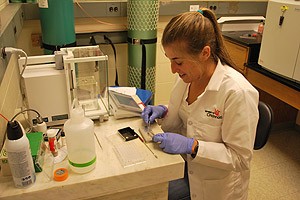
UC Undergraduate Researcher Studies the Urbanization of Southwest Ohio
As a resident of Cincinnati, it is exciting to know that my temporary home is recognized as one of the fastest-growing metropolitan areas in Ohio and the United States. However, the urbanization of Ohio is coming at a cost to Ohios natural ecosystem. Ohio is part of the Corn Belta region of the United States that is ideal for farming due to deep-fertile soils with high organic matter and relatively level land. Understanding the ecosystem impacts of urbanization, such as pollution, soil degradation, and habitat fragmentation, is crucial to developing environmentally sustainable strategies for management and development to help preserve this precious Ohio ecosystem. As a junior majoring in
, I was given the opportunity to do exactly that.
Sarah Kolbe, a PhD student in the
at the
, created the experiment Urban Gradient, to understand the effects urbanization has on forest communities along an urban-wildland gradient in Ohio. The goals of Kolbes project include furthering her understanding of the community structure of the ecosystem to better understand the effects urbanization has on Southwestern Ohio and the resiliency the ecosystem has to such changes. Kolbe found five sites in southwestern Ohio spanning the urban-wildland gradient. These areas, ranging 100 kilometers, stretch from western Hamilton County (Miami Whitewater Forest, managed by Hamilton County Park, District) to the suburbs north of Cincinnati (Harris Benedict Nature Preserve, University of Cincinnati), moving south into Cincinnati (Mt. Airy Forest, City of Cincinnati), through Clermont County, east of Cincinnati (East Fork Wildlife Area, Ohio Department of Natural Resources), and finally ending in Adams County (Edge of Appalachia, The Nature Conservancy).
My involvement with this experiment includes learning the necessary skills to appropriately analyze the wide variety of soil samples. This includes grinding soils and removing organic matter (such as roots, twigs, and rocks), wrapping and weighing samples with a microbalance in order to run them through an organic elemental analyzer. Then, through a series of combustion reactions, the analyzer produces statistical information that allows us to understand the carbon and nitrogen levels of the soil.
To understand the results of Kolbes experiment, it is important to understand what exactly urbanization is. One of the greatest causes of Global Warming is land-use change. Urbanization is land-use change and is a buzz word in the political and scientific community because as many third-world countries are industrializing they are going from rural countries to urban countries. This is similar to southwestern Ohio because the region is going from rural to urban, meaning that farms are shrinking and cities are growing.
Ecosystems are valued beyond their aesthetic value; they provide services that man cannot. Land-use changes can alter ecosystems, along with the services they provide. Urbanizing land brings an influx of people which causes great population growth. The influx of people can completely change the ecosystem services provided. For example, cities have greater carbon dioxide content because there are not as many plants to absorb CO2 through photosynthesis. This can have dramatic effects on the soil of the city. As mentioned before, one of the main ecosystem services of the Southwestern Ohio area was the fertile soil that allowed for great growth and a strong agricultural market. However, urbanizing a given area decreases the plant content, which can ultimately increase the CO2 content and cause soils to increase their acidity, making it harder and harder for agricultural yields to flourish.
This change can also have great aesthetic effects. For example, if Cincinnati soils have greater acidity it will be harder for citizens to maintain their gardens. Along those lines, this change puts great importance on the parks of Cincinnati because without them more carbon dioxide will remain in the atmosphere, increasing the effects of urbanization.
It is very exciting to have the opportunity to be a part of such a valuable research project. I hope that my research will help inspire my fellow students and citizens of Cincinnati to remember that our flourishing city is on valuable land and that it is important to make sure we live our lives with environmental consciousness.
Related Stories
OTR mural celebrates UC alumni success
April 4, 2025
The UC Alumni Association, UCAA, will mark its annual Alumni Celebration during its upcoming Alumni Week, April 7-13, with a community art project commemorating this year’s slate of alumni honorees receiving the organization’s top awards.
UC Journalism to host Hall of Fame, Young Alumni Awards
Event: April 24, 2025 6:00 PM
The College of Arts and Sciences’ journalism department will host the Hall of Fame and Young Alumni Awards to celebrate the achievements and accomplishments of its graduates. Induction into the UC Journalism Hall of Fame is a special honor reserved for UC alumni who have excelled in the profession of journalism and media, or individuals who have made a significant contribution to journalism at UC.
Bradford pear trees look pretty, smell awful. Why are they...
April 2, 2025
WLWT talks to UC biology Professor Theresa Culley about Ohio's ban on the sale or planting of nonnative and invasive pear trees. The trees are showing up in many parks and wild areas where they are crowding out native species.
